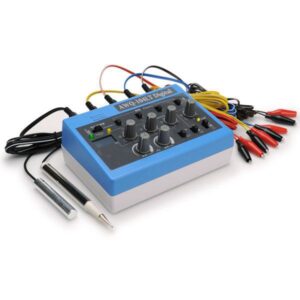by Mitch Hauschildt, MA, ATC, CSCS
Now that we have covered the how’s, why’s and when’s of dry needling, I want to cover a few areas to consider if and when the basics don’t work as well as you had hoped. When I say basics, I’m referencing inserting several needles into local tissue in an effort to change tone and downregulate pain. Traditionally, dry needling often happens at or near a trigger point. I personally believe that usually a trigger point is a symptom and not a cause. So, while I do treat them, I look for the cause of the issue and go after that as my ultimate goal.
Many times placing needles into the point of pain is effective, and I do it often, but we can do so much more than that with our needles. Below are a few thoughts and ideas to consider when needling local tissue doesn’t give you the response that you were hoping for.
E Stim
A modality that is being used more and more in dry needling circles is electrical stim in combination with needling. There is increasing evidence that using E stim with needles is effective for reducing pain. Keep in mind that you must use a stim unit that is specifically designed for dry needling and it must have proper hooks or clips to attach to the needle itself.
It is a unique approach because it allows for electrical stimulation to motor units that are deep within the muscle tissue. The goal is not to create muscle contractions (that would be painful with needles inserted). Rather, the goal is to stimulate the local receptors that modulate pain and help us with our happy centers located within our brain. There is some limited evidence that muscles are more easily activated following an electric stim dry needling session, but I think it is a bit of a stretch to say that we can use it for muscle education without some further research and development on the parameters around such technique.
Nerve Root Needling
When local needling doesn’t work as well as you would like, I recommend you go up the chain. Look at the dermatomes and myotomes that are related to the area and needle them. If you aren’t seeing progress by needling an extremity, go to the nerve root at the spine and needle that area. Oftentimes when you change neurological tone at the nerve root, you will change the tone of the tissue throughout it’s distribution. Feel free to place needles at any point along the dermatome or myotome in an effort to impact a large area.
Needling Stretched Tissue
We usually place needles into relaxed muscles, but there is a good argument for stretching the tissue and then inserting needles into it. We know that dry needling is a good technique for lowering tone in tight, hypertonic tissue, but there is some clinical evidence to support needling elongated tissue to further the relaxation of taut tissue. The idea with this technique is to place the muscle in a relaxed, but elongated position and then placing needles into that tissue. This can then be repeated in various degrees of stretch as you see improvements. I don’t use this technique a lot because it has to be the right situation with the ability to properly position the patient, but it is an interesting concept that can be used effectively for performance improvements.
Distant Needling
When you look at the evidence of needling improving central sensitization, it becomes pretty clear that by just inserting needles into the body, we can see improvements in pain globally throughout the body. What’s interesting is that we are finding that needling a seemingly unrelated area of the body will have profound effects on the injury site. And, it seems that the further away that are away from the injury, the more effective they are.
To that end, we are having success with needling the opposing calf when you are needling a shoulder. Or, needling the opposing trap when you are needling an ankle or foot injury. It seems that the further way you get from an injury, the better it works. So, don’t be afraid to drop a couple of needles into distant tissue in an effort to stimulate the nervous system and let it go to work.
Recovery
In the college setting, recovery is a big deal and a big challenge. We are always looking for ways to turn our athletes around quicker and more efficiently. Needles can do that. Some examples are needling the lats, subscap and tricep the day after a long outing for a starting pitcher or needling the hamstrings the day after an intense sprint workout for our track team. Needling will significantly improve soreness and help athletes bounce back more quickly. Just because someone isn’t injured, doesn’t mean that needles aren’t a good option for them. Assisting athletes to recover faster between training sessions is an underutilized technique in my opinion.
Conclusion
Knowing when and where to use needles continues to be the challenge and the difference between good and average clinicians. As I have said before, I don’t typically use needles as my first line treatment of choice because it is invasive and there are some risks. But, I also want to encourage you to not write off needling if a local treatment doesn’t give you great results. Oftentimes we need to expand our approach and get creative. These are a few of the approaches I take in those situations.


Leave a Reply